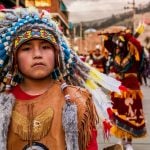Chief Sealth (Seattle), Suquamish/Duwamish Leader
Sealth was born about 1786. His father, Schweabe, was Suquamish and his mother, Scholitza, was Duwamish. As a young boy in 1792, he witnessed the arrival of the first Europeans to his area: British Captain George Vancouver entered Puget Sound and traded with the Suquamish.
In his short biography of Seattle in the Encyclopedia of North American Indians, Jay Miller reports:
“As a child Seattle was sent out to quest for spirit power, and he was successful at least once: Thunder, a powerful being, gave him abilities as a warrior and orator.”
As a young adult, Sealth successfully stopped an attack against the Suquamish by the Cascade tribes. About 1825, he set up a successful ambush on a river bend near present-day Auburn. As a result of this military success, he was designated as a tribal chief. From 1820 to 1850 he was a spokesman and diplomat for the Suquamish and other Puget Sound tribes in their dealings with fur traders and missionaries.
In the 1830s, he converted to Catholicism and was baptized as “Noah.” In his short biography of Seattle in Notable Native Americans, Tom Kunesh writes:
“With his new-found faith, he instituted morning and evening church services among Native Americans that were continued even after his death.”
In 1852, he formed a partnership with David “Doc” Maynard from Olympia to set up a fishery on Elliot Bay. He hired the Duwamish to help him build a new store and named it the “Seattle Exchange” after Chief Sealth. He filed a city plat with Seattle as the new settlement’s name. Maynard obtained Sealth’s permission to use his name for the establishment in exchange for an annual payment during his lifetime. Among the traditional Suquamish, the names of the dead are not mentioned for at least five years and the names of dead chiefs are not to be uttered for ten. The payment, a kind of royalty, was an acknowledgment of the pain which would be inflicted on Sealth after his death because a variation of his name—Seattle—would continue to be spoken.
Seattle became an important economic outlet for the Suquamish and Duwamish people and allowed them easier access to American goods.
In 1855, Sealth and other tribal leaders in the Puget Sound area signed the Treaty of Point Elliott. In the treaty council, the Americans had insisted that negotiations be done in Chinook jargon, a trade language which was limited in its ability to describe many diplomatic concepts. Sealth objected, claiming that he did not speak this language. Jay Miller reports:
“Denying knowledge of this jargon was a curious step for an intertribal figure to take, though in doing so Seattle called attention to his stature since he then required, and was provided with, a special interpreter to translate from jargon into Lushootseed for him.”
In the Treaty of Point Elliott, the Suquamish gave up most of their land in exchange for a small reservation, health care, education, and acknowledgment and protection of their rights to continue to fish and hunt. Tom Kunesh writes:
“In accordance with the treaty stipulations, Seattle and his people moved to the Port Madison reservation, located west-northwest across the Puget Sound from the current city of Seattle, on the east shore of Bainbridge Island.”
The 1855 treaties imposed on the Indian nations of Washington by Governor Isaac Stevens led to a war east of the Cascade Mountains led by Kamiakin, and the Puget Sound War led by Leschi. Despite these wars and the many grievances of the Indian people against the American invaders, Sealth kept his people at peace.
Seattle is probably best known to non-Indians for a speech which he supposedly gave in the 1850s. A summary or fragment of this speech, as remembered by Dr. Henry Smith, was published in the Seattle Sunday Star newspaper in 1887. Dr. Smith claimed to have constructed the speech from notes in his diary (now lost). In the 1930s, the supposed Chief Seattle speech was published in some non-Native publications and in the late 1960s and 1970s versions of the speech became popular among environmentalists and others. There is considerable doubt as to how much of the English language versions really reflect Seattle’s actual words. In their book Native American Almanac: More than 50,000 Years of the Cultures and Histories of Indigenous Peoples, Yvonne Dennis, Arlene Hirschfelder, and Shannon Flynn write:
“Smith’s English version of the speech has been quoted and misquoted, resulting in many published versions that range from modern renditions to fictionalized versions that made reference to railroads and rotting buffalo. No historical collection contains evidence of anything like the famous speech, so it cannot be precisely attributed to a specific day and year.”
He died in 1866 at the Old Man House winter village and is buried in the Suquamish cemetery. Yvonne Dennis, Arlene Hirschfelder, and Shannon Flynn write:
“Seattle witnessed the transition of his people from ancient lifeways to a new one brought by the arrival of non-Indians and imposed on them by the U.S. government.”
Chief Seattle’s (Sealth’s) Grave
Shown below are some photographs of Chief Sealth’s grave.
Indians 101/201
Indians 101/201 is a series exploring American Indian biographies, histories, arts, and current concerns. Indians 201 is an expansion of an earlier essay. More biographies from this series:
Indians 201: Skolaskin, a Sanpoil Prophet
Indians 201: James Welch, Novelist
Indians 201: Frank White, Pawnee Prophet
Indians 201: D’Arcy McNickle, Novelist, Bureaucrat, Activist









